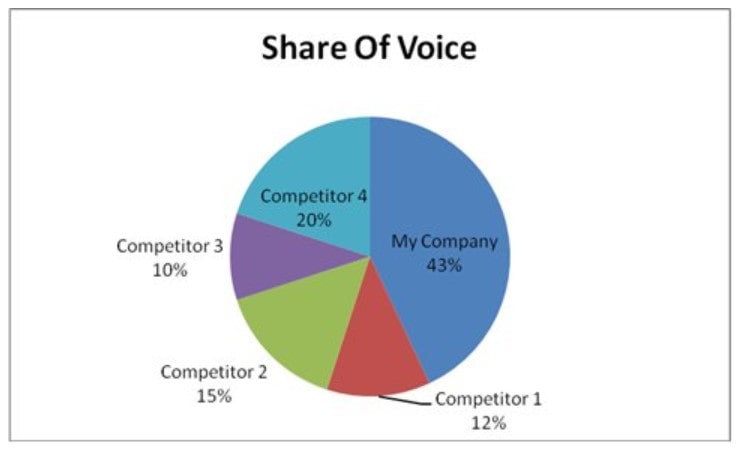What Is Share of Voice?

Hand off the toughest tasks in SEO, PPC, and content without compromising quality
Explore ServicesIn some ways, it may not appear to be a significant concern, but a thorough competitive analysis will offer a wealth of knowledge into marketing strategy and procedure, allowing you to enhance your system step by step.
But how can you compare your performance to that of your competitors? How can you obtain a fast overview of whether their efforts are successful and yours are failing, and where you stand in relation to wider trends once you’ve tracked the necessary data points?
One method is to calculate your comparative Share of Voice.
Share of Voice refers to overall online visibility, which includes organic search statistics, social media performance, and PPC performance. When these indicators are integrated, they may provide a competent evaluation of your own and each of your competitors’ market share.
In this article, we’ll define Share of Voice, its importance, how to measure Share of Voice, and discuss how it may benefit your marketing efforts.
Let’s dive in.
What Is Share of Voice?
Share of Voice (SOV) is the number of times a brand is discussed on the web in comparison to the number of times rivals’ brands are mentioned.
Share of Voice encompasses both brand awareness and customer engagement since it indicates how frequently a brand is viewed online as well as how well people interact with its content.
This is an oversimplification, but Share of Voice is like determining which portion of the pie belongs to you. Is the entire pie yours? Or do you just get a single bite of a single slice?
Share of Voice may be assessed in two ways: space ownership and potential organic traffic obtained through the SERP.
Share of Voice by space ownership determines how many organic places in a SERP belong to your business. In contrast, Traffic Share of Voice is calculated by multiplying a keyword’s search volume by the average Click-Through Rate (CTR) of your website’s position on the SERP. Both are valuable, but it is crucial to emphasize that while these competitive metrics are informative, they are not perfect.
There are a variety of reasons why they aren’t TRUE measures of Share of Voice. We don’t know how many people click on advertisements or snippets because Google doesn’t provide us with all of the data, so we assume that everyone who visits a SERP clicks into a result. Share of Voice continues to give significant information, despite the fact that it cannot be 100% precise in its assessment.
Share of Voice used to be solely about advertising activities, essentially a brand’s share of the overall advertising market. However, with the advent of social listening technologies, Share of Voice may now reflect entire online exposure, moving beyond PPC and into real-time user input.
Finally, gauging Share of Voice gives credible competitive intelligence as well as customer insights.
And, in a world when almost everything is done online, this is critical research.

Why Is Share of Voice Important?
The next of kin to market share is Share of Voice. Assessing SOV provides you with a complete view of the landscape in your market, depending on how frequently each brand name in your niche is discussed.
In fact, only 49% of the time does the top-ranking website receive the most search traffic.
Share of Voice reflects both your marketing and product decisions, making it an important statistic for assessing your entire efforts. And it may give you a variety of useful insights; here are a few examples:
- Campaign monitoring
You don’t have to limit your Share of Voice measurement to just your brand.
If there are many campaigns on the market at the same time (which there always are), you may compute SOV for each of them. You may also have access to audience-specific analytics by segmenting them by:
- Language
- Country
- Social media platform (reach, impression share, hashtags, etc)
- And more
Doing so on a regular basis can help you learn what connects with your target audience and what aspects from your rivals’ ads may inspire your own.
- Competitor intelligence
Strategic research begins with getting to know your opponent. The benefit of social listening tools is that they allow you to find new rivals, assess their Share of Voice in comparison to yours, examine the languages and sources of their mentions, and even investigate niche influencers and brand ambassadors.
Once you’ve discovered all of the top brands in your niche through competitive research, you can perform brand-by-brand comparisons to determine where you’re falling behind. Examine the overall number of mentions, then delve deeper into demographics and language details to learn from the businesses that have the most visibility in each specific region.
- Consumer insights
Because SOV calculations performed by social listening technologies are based on real-user interactions on social networks, it stands to reason that studying these conversations will provide insights into consumer habits and industry trends.
You may learn (from) your audience by listening to what they say about you and your rivals. What do people like and dislike about your products? Is your competitor underserving any sectors of the market? When you look at brand mentions, you may get all of these insights.
And, because social listening technologies allow you to communicate with consumers in-app, you can quickly handle concerns or advertise your goods to the audience of your rivals.
- Brand management
Although reputation management may not be at the top of your priority list, it is one of the most common applications for social media monitoring tools.
When assessing social media Share of Voice by retrieving and analyzing brand mentions online, social listening technologies may also do sentiment analysis, categorizing all brand mentions as positive, negative, or neutral.
This is especially important for comparing your brand’s reputation to that of your rivals in order to establish linkages between brand management and KPIs. With the preliminary data in hand, begin watching changes in your own and your competitors’ reputations over time, such as during marketing campaigns and other awareness-raising efforts.
Keeping track of the emotion of brand references enables accurate and timely analysis of client feedback.
Share of Voice FAQ
How is SEO Share of Voice calculated?
Step 1: Select Your Primary Topics
Determine your goal set of subjects for which you should rank. This should be accomplished by:
- Creating a Buyer’s Journey for each persona.
- Validating your findings by interviewing actual prospects, customers, partners, and sales representatives.
- Examining your personalities. This is the real procedure we go through with each new customer.
- A competitive keyword gap analysis should be carried out.
After completing this phase, you should have 3-5 basic core themes that correspond to each of your personas and each stage of their individual Buyer’s Journey.
Step 2: Retrieve Topical Rankings
For each of these subjects, find domains that rank on the first page of Google. Pull first-page ranking exports from the top domains ranking for each of these essential subjects using Moz, SEMrush, or another keyword research tool.
Step 3: Pivot Time Table
Put these domains in a pivot table to examine how many times a domain appears in a particular collection of subjects. Divide the number of times you rank by the total number of domains that are ranking.
Pull rankings for at least 15-30 keywords when calculating Share of Voice for your own company. You will be able to obtain a larger selection of domains this way.
What does Share of Voice tell you?
Your brand will be unable to break through the internet noise and reach new customers unless it has a large Share of Voice. Knowing your Share of Voice practically tells you stuff like:
- How successful a certain marketing effort was
- Your return on investment from a certain public relations campaign
- Which platforms are you performing well on, and which do you need to work on?
- Which advertising initiatives are successful and which are not?
Why is Share of Voice important?
Share of Voice is important since it indicates how many people are familiar with, or aware of, your brand.
As a result, it’s one of the greatest methods to assess where your brand sits in the market right now. It is a lot simpler to figure out how to go from where you are to where you want to go once you know where you are.
Prior to digital marketing, when businesses relied on print, radio, and television advertising, Share of Voice was significant since it influenced which brand a customer chose when they were at a grocery store, staring at shelf after shelf of the same product.
And, in the digital age, Share of Voice still has an impact on those things—but it also determines whether a client would scroll straight past your ad on LinkedIn, Instagram, or Facebook, or give you a fraction of their time.
This is why Share of Voice is more important than ever: Because companies are vying for even two seconds of a customer’s attention. They are not just competing with others in their market or business. They’re up against every other brand that appears in a customer’s social media feed or on the Google search results page.
Summary
Hopefully, this article has given you a better understanding of Share of Voice.
Measuring Share of Voice is the closest you can come to assessing your market share, and with the powerful social listening technologies available today, monitoring the mentions of your brand and calculating the amount of buzz you and your rivals receive makes perfect sense.
Add to this sentiment and consumer insights, and you’ve got a dependable market research engine that can be automated to give exactly what you need.
By frequently posting excellent content, you will automatically become a thought leader in your sector, improving your brand awareness and Share of Voice.
Publishing content on your own can also substantially aid your brand’s public relations efforts, as you will become known as a credible source when journalists, marketers, or bloggers want comments from an industry expert.
Share of Voice may be an effective measure for guiding your public relations and content marketing channels and operations.
But keep in mind that Share of Voice metrics simply monitors the number of your online mentions, not the quality. If you are regularly referenced in small blogs with few followers, you will not be able to rank in the first few pages of Google. Similarly, if you’re being mentioned everywhere as a result of a crisis or controversy, your Share of Voice may be massive—but it won’t be helpful for your brand.
If you want to increase your brand’s Share of Voice, digital PR might be just what you need.
Hand off the toughest tasks in SEO, PPC, and content without compromising quality
Explore ServicesWritten by Aaron Haynes on December 20, 2021
CEO and partner at Loganix, I believe in taking what you do best and sharing it with the world in the most transparent and powerful way possible. If I am not running the business, I am neck deep in client SEO.





